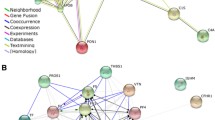Abstract
Following bone fracture, a large number of growth factors, cytokines, and their cognate receptors involved in the repair process are active at the fracture site. To determine whether they appear in patients’ blood as candidate biomarkers for following the outcome of healing, we analysed the plasma of 25 patients with an acute bone fracture following affinity plasma purification, SDS gel electrophoresis and liquid chromatography - tandem mass spectrometry (LC-MS/MS). Two hundred and thirteen nonredundant proteins were identified in the in-gel analysis of pooled plasma proteins. Gene ontology (GO) analysis indicated that a majority of detected proteins were of extracellular origin, whereas only a small number were of intracellular (cytosol and nucleus) origin. A significant proportion of detected proteins was involved in the cell growth and proliferation, transport and coagulation. Twelve proteins were potentially related to bone and cartilage metabolism, and several have not been previously identified in the plasma, including: TGF-β induced protein IG-H3, cartilage acidic protein 1, procollagen C proteinase enhancer protein and TGF-β receptor III.
Résumé
Après une fracture, un grand nombre de facteurs de croissance, cytokines et leurs récepteurs apparentés interviennent dans le processus de réparation des foyers de fracture. Nous avons analysé ces différents facteurs circulants chez 25 patients ayant présenté une fracture après purification du sang, électrophorèses, chromatographie et spectrographie de masse. 213 protéines ont été identifiées. L’analyse génétique de la majorité de ces protéines montre qu’elles sont d’origine extra cellulaires avec un très petit nombre de protéines intra cellulaires provenant notamment du noyau. Une proportion significative des protéines détectées intervient au niveau de la croissance, de la prolifération cellulaire et des phénomènes de coagulation. 12 protéines sont spécifiquement en rapport avec les métabolismes osseux et cartilagineux, plusieurs d’entre-elles n’avaient pas été préalablement identifiées au niveau du plasma comme la TGF-β, la protéine IG-H3, la CAP 1, le procollagène de type C, le TGF-β récepteur III.


Similar content being viewed by others
References
Anderson NL, Anderson NG (2002) The human plasma proteome. Mol Cell Proteomics 1:845–867
Barnes GL, Kostenuik PJ, Gerstenfeld LC, Einhorn TA (1999) Growth factor regulation of fracture repair. J Bone Miner Res 14:1805–1815
Dong M, How T, Kirkbride KC, Gordon KJ, Lee JD, Hempel N, Kelly P, Moeller BJ, Marks JR, Blobe GC (2007) The type III TGF-β receptor suppresses breast cancer progression. J Clin Invest 117:206–217
Grgurevic L, Macek B, Erjavec I, Oppermann H, Mann M, Vukicevic S (2007) Urine release of systemically administered bone morphogenetic protein hybrid molecule. J Nephrol 20:311–319
He P, He HZ, Dai J, Wang Y, Sheng QH, Zhou LP, Zhang ZS, Sun YL, Liu F, Wang K, Zhang JS, Wang HX, Song ZM, Zhang HR, Zeng R, Zhao X (2005) The human plasma proteom: analysis of Chanise serum using shotgun strategy. Proteomics 5:3442–3453
Henle P, Zimmermann G, Weiss S (2005) Matrix metalloproteinases and failed fracture healing. Bone 37:791–798
Jones AR, Gleghorn JP, Hughes CE, Fitz LJ, Zollner R, Wainwright SD, Caterson B, Morris EA, Bonassar LJ, Flannery CR (2006) Binding and localization of recombinant lubricin to articular cartilage surfaces. J Orthop Res 25:283–292
Massague J (1998) TGF-beta signal transduction. Annu Rev Biochem 67:753–791
Olsen JV, de Godoy LM, Li G, Macek B, Mortensen P, Pesch R. Makarov A, Lange O, Horning S, Mann M (2005) Parts per million mass accuracy on an Orbitrap mass spectrometer via lock mass injection into a C-trap. Moll Cell Proteomics 4:2010–2021
Pecina M, Giltaj LR, Vukicevic S (2001) Orthopaedic applications of osteogenic protein-1 (BMP-7). Int Orthop 25:203–208
Rhee DK, Marcelino J, Baker M, Gong Y, Smits P, Lefebvre V, Jay GD, Stewart M, Wang H, Warman ML, Carpten JD (2005) The secreted glycoprotein lubricin protects cartilage surfaces and inhibits synovial cell overgrowth. J Clin Invest 115:622–631
Schmidt TA, Schumacher BL, Klein TJ, Voegtline MS, Sah RL (2004) Synthesis of proteoglycan 4 by chondrocyte subpopulation in cartilage explants, monolayer cultures and resurfaced cartilage cultures. Arthritis Rheum 50:2849–2857
Schumacher BL, Schmidt TA, Voegtline MS, Chen AC, Sah RL (2005) Proteoglycan 4 (PRG4) synthesis and immunolocalization in bovine meniscus. J Orthop Res 23:562–568
Simic P, Vukicevic S (2007) Bone morphogenetic proteins: from developmental signals to tissue regeneration. Conference on bone morphogenetic proteins. EMBO Rep 8:327–331
Steck E, Braun J, Pelttari K, Kadel S, Kalbacher H, Richter W (2007) Chondrocyte secreted CRTAC1: a glycosylated extracellular matrix molecule of human articular cartilage. Matrix Biol 26:30–41
Turley RS, Finger EC, Hempel N, How T, Fields TA, Blobe GC (2007) The type III transforming growth factor-β receptor as a novel tumor suppressor gene in prostate cancer. Cancer Res 67:1090–1098
Author information
Authors and Affiliations
Corresponding author
Rights and permissions
About this article
Cite this article
Grgurevic, L., Macek, B., Durdevic, D. et al. Detection of bone and cartilage-related proteins in plasma of patients with a bone fracture using liquid chromatography–mass spectrometry. International Orthopaedics (SICO 31, 743–751 (2007). https://doi.org/10.1007/s00264-007-0404-z
Received:
Revised:
Accepted:
Published:
Issue Date:
DOI: https://doi.org/10.1007/s00264-007-0404-z




